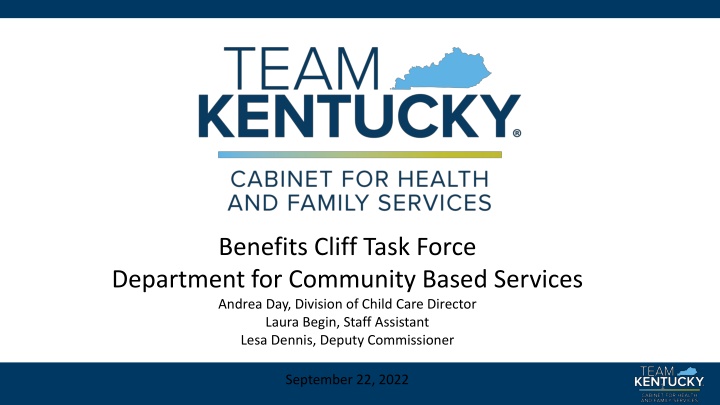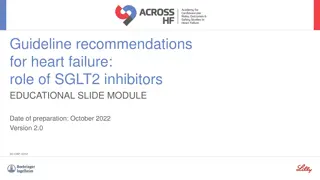
Child Care Assistance Program in Kentucky - Overview and Updates
Explore the Child Care Assistance Program (CCAP) in Kentucky, supporting low-income families with child care costs. Learn about eligibility changes, provider reimbursement rates, and income guidelines to ensure accessibility for working families.
Download Presentation

Please find below an Image/Link to download the presentation.
The content on the website is provided AS IS for your information and personal use only. It may not be sold, licensed, or shared on other websites without obtaining consent from the author. If you encounter any issues during the download, it is possible that the publisher has removed the file from their server.
You are allowed to download the files provided on this website for personal or commercial use, subject to the condition that they are used lawfully. All files are the property of their respective owners.
The content on the website is provided AS IS for your information and personal use only. It may not be sold, licensed, or shared on other websites without obtaining consent from the author.
E N D
Presentation Transcript
Benefits Cliff Task Force Department for Community Based Services Andrea Day, Division of Child Care Director Laura Begin, Staff Assistant Lesa Dennis, Deputy Commissioner September 22, 2022 1
The Child Care Assistance Program (CCAP) CCAP is a public assistance program for eligible low-income, working families in which their child care provider directly receives part or the entirety of the child s tuition costs from the cabinet. As of May 2022, there were 15,096 families (26,946 children) enrolled in CCAP and over 1,600 child care providers participating in the program. 2021 changes to provider reimbursement rate re: General Fund appropriation and American Rescue Plan Act (ARPA) funds 2022 changes to eligibility from 160% federal poverty level (FPL) to 200% FPL, and then from 200% FPL to 85% state median income (SMI) 2022 transitional exit period implemented for households exceeding income limits (50% payment rates) to address the benefits cliff 2
Cost of Child Care Average cost of care for one child statewide: Average Daily Rate Preschool Average Weekly Rate PS Average Monthly Rate PS Infant/Toddler School Age I/T SA I/T SA Licensed Type I Full Day Part Day $ $ 38.33 33.94 $ $ 33.46 26.74 $ $ 30.22 22.03 $ 191.65 $ 169.70 $ 167.30 $ 133.70 $ 151.10 $ 110.15 $824.10 $ 729.71 $ 719.39 $ 574.91 $ 649.73 $ 473.65 Licensed Type II Full Day Part Day $ $ 31.98 27.03 $ $ 28.73 24.45 $ $ 28.70 24.52 $ 159.90 $ 135.15 $ 143.65 $ 122.25 $ 143.50 $ 122.60 $ 687.57 $ 581.15 $ 617.70 $ 525.68 $ 617.05 $ 527.18 Licensed Type I/II Combined Full Day Part Day $ $ 35.16 30.52 $ $ 31.10 25.60 $ $ 29.46 23.28 $ 175.78 $ 152.60 $ 155.48 $ 128.00 $ 147.30 $ 116.40 $ 755.84 $ 655.43 $ 668.55 $ 550.40 $ 633.39 $ 500.52 Type I 4 or more children in a non-residential setting Type II No more than 12 children Makes up 88% of child care providers in Kentucky 3
CCAP Eligibility Change to 200% FPG Benefitted from 200% FPG change Month - Year Jan-22 Feb-22 Mar-22 Apr-22 May-22 Jun-22 Grand Total Number of distinct cases Children count Expenditures 212 313 $124,834.00 140 219 $194,592.00 132 186 $283,885.00 154 224 $321,251.00 140 211 $374,805.00 137 197 $406,916.00 915 1,350 $1,706,283.00 4
CCAP Eligibility Change from 200% FPG to 85% SMI Benefitted from SMI change Month - Year Expenditures Number of distinct cases Children count July -22 155 222 $34,695.00 5
Updated Income Guidelines for CCAP Annual Income Cut-Off $44,916 Family Size 200% FPG/Monthly 85% SMI/Monthly $2,903 $3,743 2 3 4 5 6 7 8 $55,476 $3,660 $4,623 $66,048 $4,417 $5,504 $84,992 $5,173 $6,384 $87,180 $5,930 $7,265 $89,160 $6,687 $7,430 $91,140 $7,410 $7,595 Add $166 for each Over 8 6
Co-Payments The Division of Child Care utilized Coronavirus Response and Relief Supplemental Appropriations (CRRSA) Act funds to cover the parent copayments for CCAP recipients. Approximately $23 million spent since April 2021 Approximate cost of $1.5M per month ($18M per year) to discontinue CCAP copayments (discount to zero) and increasing over time Difficult to estimate due to CCAP payments and copayments varying greatly from month-to-month 7
Benefits Cliff Impact The benefits cliff experienced in CCAP is one of the largest impacts to a family s budget, if not the largest. A family with two children in child care experiences a benefits cliff of approximately $1,500 per month once exiting CCAP. Fifty-six children continued to receive 50% assistance under new transitional exit period. Transitional exit period just expanded from 3 months to 6 months. 8
Other Public Assistance Benefits and Effect of Benefits Cliff Assumption that those receiving benefits are a constant population; that a person receiving benefits today has received them for years in the past and will receive them for years in the future. Supplemental Nutrition Assistance Program (SNAP) data does not support this, particularly for working-age adults. National studies show 74% of adults work in either the 12 months prior to, during, or the 12 months following any particular month of SNAP receipt. Two-thirds of working adults receive benefits for fewer than 24 months, enforcing that these are workers frequently losing and regaining eligibility. Those who stay in the program longer are still working most months they receive benefits. 9
Economic Conditions and SNAP Participation As an example of how economic conditions influence the overall usage of SNAP benefits, we can look at the 2009 recession and recovery. Caseloads climbed as jobs became scarce and wages were low. At its peak in July 2013, SNAP served just under 880,000 individuals. As the state recovered, three years later participation was down to just over 670,000 individuals, a 25% reduction. Participation is now about 547,000 individuals (about 250,000 households). 10
Economic Conditions and SNAP Participation SNAP Participation FFY08-16 1,000,000 900,000 800,000 700,000 600,000 500,000 400,000 300,000 200,000 100,000 0 10/07 12/07 02/08 04/08 06/08 08/08 10/08 12/08 02/09 04/09 06/09 08/09 10/09 12/09 02/10 04/10 06/10 08/10 10/10 12/10 02/11 04/11 06/11 08/11 10/11 12/11 02/12 04/12 06/12 08/12 10/12 12/12 02/13 04/13 06/13 08/13 10/13 12/13 02/14 04/14 06/14 08/14 10/14 12/14 02/15 04/15 06/15 08/15 10/15 12/15 02/16 04/16 06/16 08/16 Households Individuals 11
Economic Conditions and SNAP Participation Similarly, the recent pandemic showed an initial spike in SNAP participation, but it, too, returned to normal as the economy rebounded. It should be noted that both the Great Recession and COVID-related SNAP participation reductions occurred with no mandatory work program in place for any SNAP recipient. Although economic conditions warranted a waiver from work requirements, SNAP recipients went back to work when jobs were available. 12
Economic Conditions and SNAP Participation SNAP During COVID 700,000 600,000 500,000 400,000 300,000 200,000 100,000 - 03/20 04/20 05/20 06/20 07/20 08/20 09/20 10/20 11/20 12/20 01/21 02/21 03/21 04/21 05/21 06/21 07/21 08/21 09/21 10/21 11/21 12/21 01/22 02/22 03/22 04/22 05/22 06/22 07/22 Household Individuals
SNAP is Temporary and is One of the First Benefits Lost in the Benefits Cliff This means that for a vast majority of working-age adults, SNAP provides a temporary support to help households get through major crises, such as loss of a job, temporary illness, family emergencies, etc. Most of us, whether we re aware of it or not, know someone a family member, a friend who needed assistance from SNAP or other programs at one point in their lives. For most, it was a temporary situation until they had sufficient income to no longer need the help. 14
Non-working SNAP Participants A smaller percentage (approximately 20% of working-age adults) were not working in the national study - about the same for Kentucky. Barriers to employment were varied and still exist today: Caretaking responsibilities the expense of child and elderly care Health conditions (not yet rising to the level of disability receipt, but still preventing employment) Low educational attainment Unstable housing/homelessness The SNAP Employment and Training Program is designed to assist households overcome barriers. Community Action Kentucky, Inc., is one of several partners across the state demonstrating success with this program. 15
Benefits Cliff Calculator House Bill 7 (RS22) required the Cabinet for Health and Family Services (CHFS) to develop a proposal to make a benefits cliff calculator available to the general public and all individuals applying for public assistance benefits. The Kentucky Center for Statistics (KYSTATS) partnered with the National Center for Children in Poverty to create a Family Resource Simulator (FRS). The FRS is a benefits cliff calculator designed to help families understand how changes in income will impact benefits like healthcare, child care, etc. CHFS will work with KYSTATS to increase accessibility and functionality for public assistance recipients. 16
Family Resource Simulator https://kystats.ky.gov/FRS/GetStarted Already being utilized by workforce partners Public assistance case managers currently use the FRS to assist individuals looking for work Utilized over 1,100 times since launch in July Example shows family s resources and benefit cliffs they will experience as their income increases 17
Ongoing Work Phase 1 CHFS and KYSTATS will work together to enhance existing interface Approximate completion by July 2023 Phase 2 FRS will be integrated with kynect benefits system Allow individuals that are applying, reapplying, or receiving benefits to access the calculator with their personal information prepopulated Improve the accuracy and ease of use of the calculator Approximate completion by July 2024 18
Online Job Postings House Bill 7 also required CHFS to develop an online job postings database available to the general public. The Education and Labor Cabinet (ELC) uses Focus Suite, an automatic job-match engine containing online tools for career seekers and employers 24,000 active job seekers have accessed the site in the past 90 days Beginning in September ELC will be adding a suite of LinkedIn tools CHFS is linking kynect to these Focus and LinkedIn tools 19






















